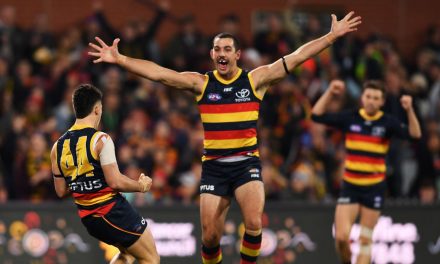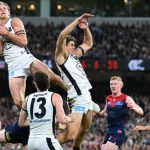The AFL’s Steve Hocking has once again drawn a lot of attention over recent rule changes. Photo: GETTY IMAGES
Daniel Healy is on the war path. And it would be entertaining to be the “fly on the wall” if the former St Kilda player and Central District SANFL premiership captain ever crossed paths with AFL football boss Steve Hocking.
Healy, now part of the Leading Teams leadership mentoring programs in Adelaide, is far from convinced with Hocking’s latest tinkering with the Australian football rule book to save “the look of the game”.
He cannot stomach the new man-on-the-mark rule that demands a player stand on the spot – rather than move along the mark to cut off the “angles”, in particular the creative 45-degree kick. He can still jump. He can still wave his arms. He can still offer advice … but he cannot move until the umpire in the zone calls “play on”. He is the scarecrow. A statue.
If he moves before that “play on” call, the umpire is compelled to drag the mark back 50 metres. It is some penalty.
Gone is the concept of digging the boots into the turf to spot the mark, moving back a few metres and running at the kicking in the hope of touching the ball if the kicker misjudges the mark. Or, to avoid this outcome on a goalscoring opportunity, forcing the kicker to go back a fair distance that it adds an extra metre or two on the shot at goal.
Curators must be happy to not have their manicured carpets subject to gouging anymore. Forwards will find defenders are indeed like those stiff plastic screens they kick over at training.
But Healy does not like it – nor the underlying theme of the rule change.
“You’re asking me to actually not try,” Healy already has told Hocking in the social media space. “What other sport would do that? Imagine telling a fielder (in cricket) they can’t move to chase a ball.
“Farcical!”
The pre-season – reduced to just one big week of derbies – was hardly the scientific sample pot to determine who is right: Hocking or Healy? The nine matches produced an average score of 88 points – compared with 80 points in the 2019 AFL home-and-away season when the league last had 20-minute quarters. Six of the 18 teams scored more than 100 points in these practice matches, but no game had both competitors break the 100-point marker in the same game.
Round 1 of the new AFL premiership season delivered an 85-point average – and four of the 18 teams broke the watershed 100-point barrier (league premier Richmond with 105, 2020 minor premier Port Adelaide with 117, last year’s wooden spooner Adelaide with 103 and Sydney without Lance Franklin scoring most with 125 points).
There is a fair bit more footy to play out before this rule change can be fairly judged.
And, as usual, there will be seemingly endless debate for the after-match press conferences and the Monday night panel shows, particularly if a game is decided (as many fear) with a 50-metre penalty on the mark. As Western Bulldogs premiership coach Luke Beveridge has noted, the demands on the umpires just get tougher.
“The umpires need to rub their tummy and pat their head at the same time with this rule,” Beveridge said. “It’s like a gun fight on the streets of Tombstone, it’s whoever flinches first really.
“The umpire has to keep his eye on the player with the ball and the guy on the mark. It’s too hard to do that, so whoever moves first, it’s either play-on because the guy with the ball moves first, or it’s a 50-metre penalty if the guy on the mark moves first.
“My feedback was, it’s not about the ones they’ve paid, it’s the 15 to 20 during the game that they didn’t pay when they were there, whether it’s play-on or a 50-metre (penalty).
“You can’t actually umpire the rule to the letter that they’re trying to umpire it. They’ll have to bend and let the guy on the mark move a little bit, or it’s not going to work.
“If they don’t do that, the grandstands are going to fall down at the MCG with these 50-metre penalties.”
Since moving from Geelong’s football department to the AFL football office in 2017, Hocking has taken up the perpetual battle between the rule makers and the AFL coaches (senior and assistant) with vigour.
But who is winning? And why does it need to be a battle?
First-year North Melbourne coach David Noble is one of the most qualified analysts of Australian football for his vast and diverse experiences as a player, coach, football administrator, recruiter, list manager and valued member of AFL sub-committees and panels.
Asked on Adelaide radio during the Kymbo and The Rooch Show who decides how the game is played – rule makers or coaches – Noble replied: “Coaches shape it more. We try, not to bend the rules, but manoeuvre it around to the best advantage.
“We all want the game to look great. We all love our players. There should not be any question that we have the game’s best interests at heart.
“Coaches get criticised at times too much for making the game look a certain way.
“If you talk about influence (on the game), the coaches have the most influence.”
Every adjustment Hocking makes inevitably puts the coaches in a race to find the “unintended consequences”. As South Australian football legend and former Laws of the Game committee member John Halbert told us last year: “(Premiership coach) David Parkin bumped into me in the lobby of AFL House after we finished a (rules) meeting and said to me, ‘John, by the time you left the lift, the coaches were already finding a way to beat your new rules’.”
PLEASE HELP US CONTINUE TO THRIVE BY BECOMING AN OFFICIAL FOOTYOLOGY PATRON. JUST CLICK THIS LINK.
Hocking is fighting the mentality of the coaches. Tell an AFL coach it will be easier to score – and thereby lose a game and their jobs in the ultimate win-loss career – and he will most likely think how he can strengthen his defensive systems rather than load up the scoreboard. There are not many Malcolm Blights in AFL coaching ranks today eager to take on the challenge of outscoring a rival.
So would Hocking be more successful in saving the “look of the game” if he put away the stick to offer carrots? Geelong and former Adelaide forward-ruckman Josh Jenkins has endorsed incentives for scoring by advocating bonus points for high scoring – a theme long ago adopted in domestic cricket with the Sheffield Shield.
Where cricket had its Geoff Boycott, Australian football had its Ross Lyon at Fremantle in 2016 when Jenkins thought it was time to add the BP column to the AFL premiership table.
Jenkins observed: “Fremantle were suffocating teams, but winning every week with final scores like 70 to 50, commentary was critical and many said coach Ross Lyon had a duty to the game to improve his scoring output. Lyon’s response was 100 percent correct: ‘I have a duty to win games’.
“He was absolutely spot on. Coaches implement game styles that most effectively suit their squad. It is their job to put their team in a position to win. The aesthetics of the game are not more important than wins and losses.
“However, attacking football should always be encouraged.”
Jenkins’ carrot was bonus points for scoring 100 points – even on losing a match.
“Put finals places at stake,” said Jenkins, “and you will see 18 teams playing run-and-gun, up-tempo, high-scoring footy – something I know we would all love to see long-term.”
Every suggestion inevitably gets pulled apart. How is scoring affected under the roof of the Docklands stadium or at night when the dew hits Adelaide Oval? Or the humidity in Darwin? What of those monsoonal rain events in Queensland? And those gales from the South Pole at Hobart?
The 23-round AFL fixture already seems loaded with potentially decisive oddities.
Sometimes, the best judges in these debates are those who have cleared their lockers of self-interest – such as premiership-winning coach (and now successful horse trainer) Denis Pagan.
The former North Melbourne coach was still captivating with his well-reasoned judgment when he was asked of Hocking’s running battle with today’s AFL coaches.
Pagan said: “Everything you need to know in football is written in the game’s history – and we don’t learn from it.
“I will tell you a thing about the rules committee … the AFL should buy them all a one-way ticket to Hawaii. Send them away and tell them to stay away.
“The game will look after itself. Why make changes? The game has stood the test of time for 150 years. So many people on the rules committee want to justify their existence.
“You don’t need to make rule changes because the coaches will manipulate the changes you make. Leave the game alone. It will work itself out.
“If coaches want to play slow football, if they want to take a talented squad and have it make perfect passes to perfect leads, they will need to do it properly … or (the coach) will be out of a job within two years.
“It all gets back to the coaches.
“And a lot of young coaches want to reinvent the game. Yet nothing has really changed since Day 1. The key to success is to do the basics well over and over again.
“Tom Hafey in the 1970s won four premierships at Richmond by getting the ball (into attack) quickly and deeper. It is a simple process that is not hard to teach the players.”
So the battle goes on – Steve Hocking v AFL coaches, assistants and all.
Many fans note Australian football is forever tampering with its rule book while other sports, in particular world football, resists. A review of the AFL’s so-called “bible” highlights that from the peacetime era since 1945, decade by decade –
1940s – Three rule changes; most significant being the use of two reserves, the 19th and 20th man, from 1946.
1950s – Four rule changes; introduction of runner carrying coach’s message from 1955.
1960s – Six rule changes; flick pass banned in 1966.
1970s – Five rule changes; centre diamond in 1973, centre square from 1975 and interchange from 1978.
1980s – Six rule changes; 50-metre penalty introduced in 1988.
1990s – 14 rule changes; “Prior opportunity” written into holding-the-ball rule in 1996.
2000s – 23 rule changes; minimum length of kick that qualifies for a mark increased from 10 to 15 metres in 2002.
2010s – 23 rule changes; 6-6-6 formations at centre bounce introduced in 2019 when kick-in rule also was changed.
It is not one rule change that ultimately transforms the game. There is the domino effect.
The AFL is not – as many suggest – a Lone Ranger on the rules front. Its American cousin, the National Football League (NFL), also appears to have an annual routine of adapting its rule book with a well-defined philosophy:
“Throughout the history of the NFL, the custodians of the game not only have protected its integrity, but also have revised its playing rules to make the contests fairer, safer and more entertaining. Time and again, the league has shown that it is open to ideas generated by any source or circumstance – or even by new technology – if it believes that the changes will improve the game.
“Now spearheaded by the competition committee, the NFL rules-changing process is systematic and consensus-oriented. Widely agreed-on ideas may be quickly approved and implemented. Others take years to make it from a proposal to the field. Some evolve over time. And although the vast majority of proposed rule changes are never adopted, all are carefully considered.”
The NFL mothballed its rules committee to engage a group of nine team executives and coaches as its competition committee (a theme Hocking brought to the AFL last year). The NFL has the team owners decide on rule changes; the AFL has the commission.
The NFL competitions committee in 2012 wrote in its report: “If someone wants to accuse the National Football League of promoting offense to make the game more exciting, (the committee) believes the league should plead guilty.”
The NFL also acknowledges it does not always get it right – and there are “unintended consequences”. But, the Americans insist, “it’s what the league must do – for the good of the game.”
“Whether for fairness, safety or entertainment, the NFL remains open to change,” they add.
The AFL appears to be working from the same playbook when the Australian professional football league reviews its rules. The reality appears the coaches do the editing …













Sorry, where’s the solution this article promises?